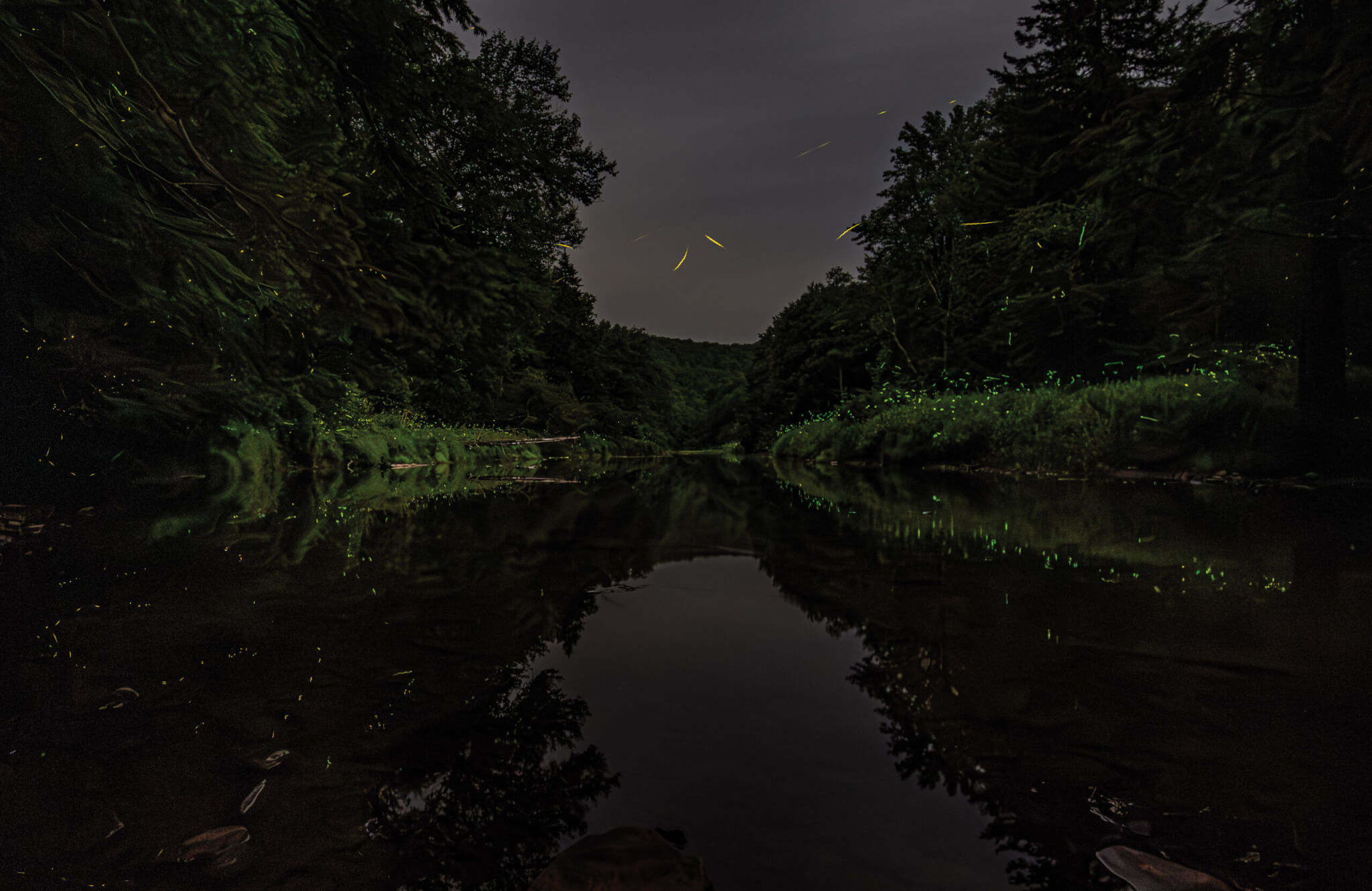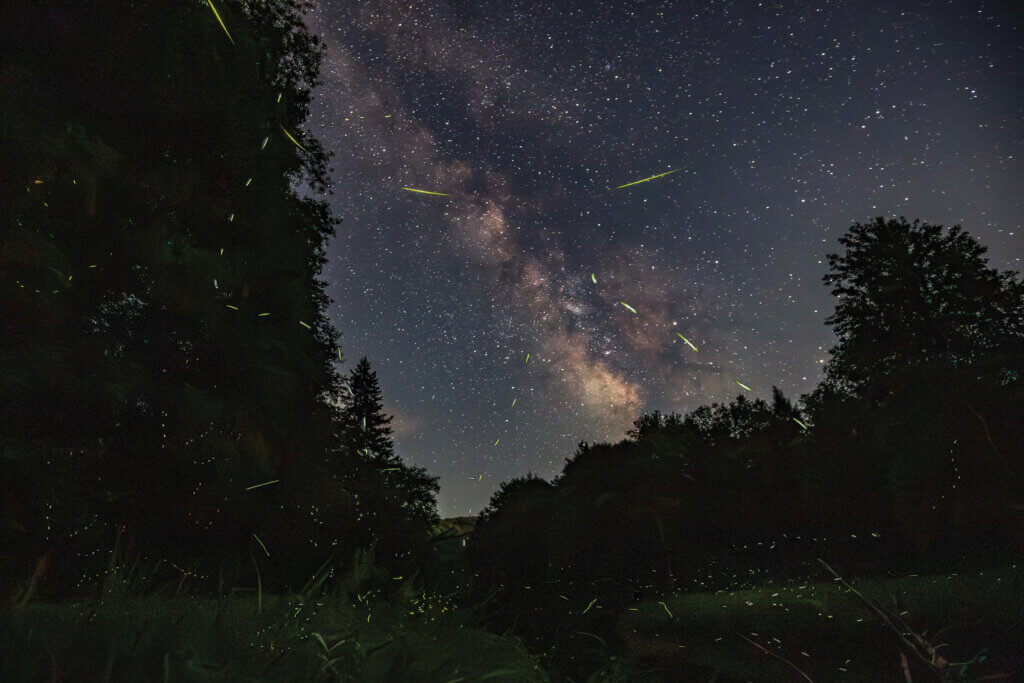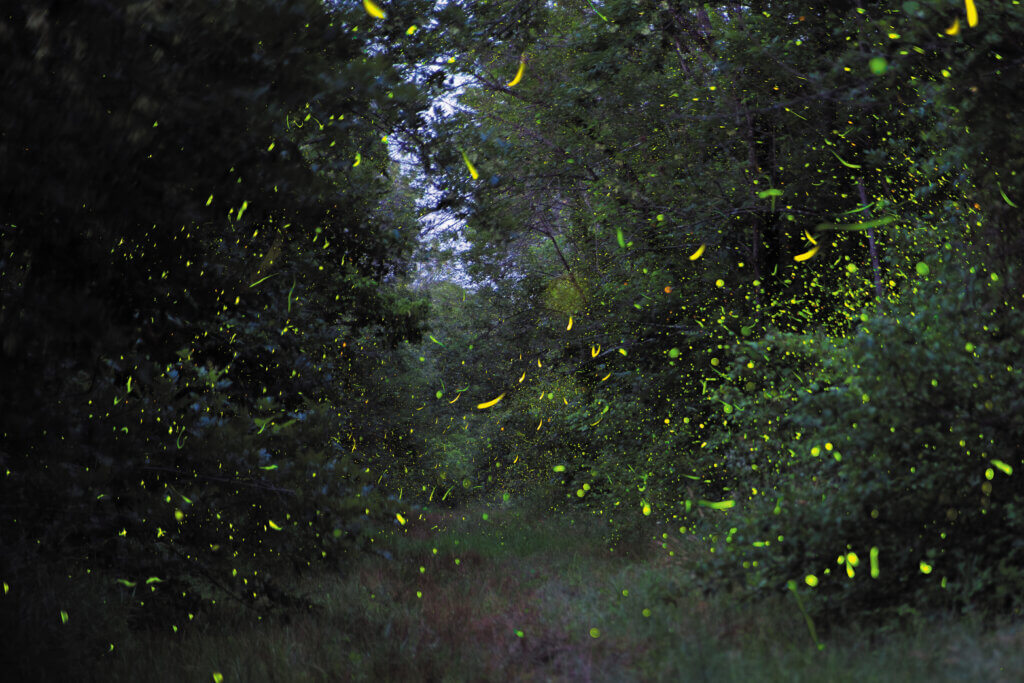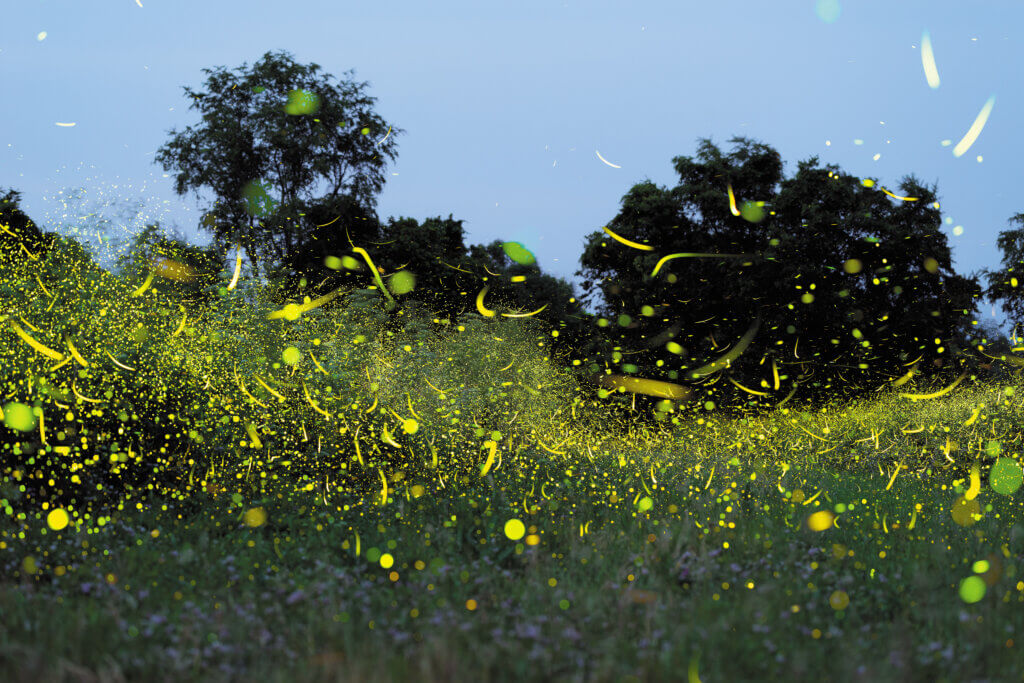
Tracking our greatest fireworks display with WVDNR.
This story was originally published in the June 2024 issue of Wonderful West Virginia. To subscribe, visit wonderfulwv.com.
written by Stan Bumgardner

In one of my earliest memories, I’m about 3 years old in my great-aunt’s backyard, watching in amazement as millions, maybe zillions, of fireflies sparkle all around me. To a tiny tot, the constellations must have fallen to Earth. But something was even more unusual: These stars were rising from the ground.
Nearing my 60s now, most of my childhood memories have faded away or lost their magic. Every summer, though, right at dusk, nearly six decades of that magic comes rushing back, and in my own backyard.
Maybe the most magical thing about fireflies—we called them lightning bugs—is that they still exist at all. Based on fossil records, they’ve been around for nearly 100 million years, so they work very hard at surviving.
Logging the Lights
Does it seem like we see fewer fireflies than we used to? It just might not be our imaginations. Loss of habitat, pesticides, and other environmental issues are thought to have thinned their numbers, but there’s relatively little scientific data to back up what we’ve been seeing with our own eyes.
That’s all changing through a systematic firefly tracking project, and the West Virginia Division of Natural Resources (DNR) needs our help. Light Up West Virginia is a community science survey that documents the types and locations of our fireflies and glow-worm species. We currently have at least 31 species of the 172 species—and counting—found throughout the United States and Canada. The phrase “at least” carries a lot of weight here, because we don’t know for certain how many exist. Some bugs recently identified by community scientists are clearly fireflies, but some are, well, something else. That’s why capturing the baseline data is critical for DNR to track their future growth or decline.

Which Firefly is Which?
So, unless you’re a fellow firefly, how do you tell one kind from another?
It mostly comes down to flash rates and patterns. The blinking rhythm and number of flashes are fairly unique to each species. DNR’s Natural Heritage Program officially confirms the fireflies based on those descriptions, where they were seen, the climate, and their colors and markings.
If you’re wondering why species flash differently, that’s something only fireflies know for sure. Some of it relates to oxygen production and to warn predators. Fortunately for fireflies, they don’t taste very good, so the light show is one way of telling their enemies, “You know, you can find something a whole lot better to eat than us.”
As you might surmise, the main purpose of the light show has more to do with the birds and the bees than it does insects. The firefly, like every living thing, has a natural instinct to perpetuate itself. Those light shows are the males’ attempts at flirting. We typically don’t see the females, because they’re perched in trees and hidden by leaves. Females play an intriguing role in this mating ritual. As part of their flash dance with potential suitors, females of the genus Photuris—one of several genera represented in the state—can mimic the blinking patterns of other species, luring their males in and killing them to swipe their defensive chemicals.
“They’re known as Photuris femmes fatales in the firefly world,” says Krista Noe, an assistant zoologist with DNR’s Natural Heritage Program. “It’s more brutal than the magical world most people imagine.”
Every year, Noe and her supervisor, zoologist Mack Frantz—who started the Natural Heritage Program and Light Up West Virginia—feed all the survey data into a project called NatureServe, which identifies rare species across the country. Noe clarifies that the program doesn’t identify rare species in general, but ones rare to West Virginia or a particular region.
“For instance, if we’ve seen this species here, here, and here,” she says, “we know it’s not so rare.” She and her fellow staff then assign a state rank based on how common it is within our borders.
Our location makes us particularly significant to the national survey. “West Virginia,” Noe observes, “is a very cool state geographically because there are a lot of southern species whose northern extent is West Virginia, and some northern species’ southernmost extent is West Virginia.”
It just depends on the type. Some are attracted to the cooler Allegheny Highlands—unique settings such as Cranberry Glades, where the climate and habitat almost resemble that of Canada. Noe adds, “Those firefly species might not be rare in Canada, but they are in West Virginia.” Documenting these nomadic insects in faraway locations helps the DNR better understand our natural environment overall.
Every year since the survey started, community surveyors have spotted new species. One is the Potomac firefly, Photuris potomaca, which used to be abundant in the Potomac River watershed of West Virginia, Maryland, and Virginia, with a few also found in Ohio and Kentucky. Now considered rare, its numbers have seemingly declined as our Eastern Panhandle has become more suburban than rural in some areas. In fact, no Potomac fireflies had been positively identified in West Virginia for decades. The survey changed all that. Perhaps the Potomac firefly is making a dramatic comeback, or maybe it just wasn’t being documented. That’s the survey’s whole goal: determining how commonplace our fireflies really are and why.
The Natural Heritage Program staff is publishing a paper on the Photuris potomaca discovery in The Coleopterist, a prominent British scientific publication, which Noe laughingly describes for us lay folks as “a beetle journal.”

The Survey: What We Can Do
Light Up West Virginia is a version of what some may remember as the old citizen science survey. The fun part is that we all—from toddlers to retirees—get to play science detectives.
“We want people to go out to West Virginia state parks,” says Noe, “and tell us what they see. We can’t be everywhere, so community data on fireflies are very helpful to us.”
The DNR doesn’t want us volunteer trackers to catch or kill fireflies. Your visual description provides the best clues. Based on this information, Noe says, “We can make a pretty good scientific guess on what the species is.”
The various West Virginia firefly species mate, and therefore flash, any time between late April and into August. Noe points out some of the characteristics to look for. “Document their flash patterns, the habitat you’re in, and the time of night, because some species flash earlier and some flash later.” Some produce “flash trains”—seemingly endless repetitive patterns. The Potomac firefly is known for these. “I’ve counted up to 60 flashes in a row,” Noe says. “Blink, blink, blink, blink, on and on.”
At the other end of the blink scale, we have one of the most common fireflies: Photinus pyralis, known by many names, including the big dipper. It blinks just once and pauses for what can seem like an eternity before flashing again. And there’s every type of flash pattern in between—some with syncopated but consistent rhythms that resemble Morse Code signals.
If you can get close enough, coloring is another important factor, although Noe says that information can be less reliable because people can see colors a little, or a lot, differently.

The Joy of Science
Noe absolutely loves what she does. She laughingly says, “I’ll talk about fireflies to anyone who lets me. It started out as an everyday work thing, but now I’ve fallen in obsession with fireflies.”
It’s telling in how she speaks about them. Her voice emotes a touch of melancholy when reflecting on their short life spans: about a year. Fireflies typically spend most of that time underground in the larval stage. With only weeks to live, they emerge to mate. While we’re oohing and awing at their beauty, they’re desperately trying to continue their species. “That’s the whole name of the game,” Noe says.
Contribute to the Light Up West Virginia firefly survey
DNR needs observations from all across the state! If you expect to see fireflies this summer on state lands or elsewhere, take a few minutes to get yourself ready as a citizen scientist.
Review the short training video at https://wvdnr.gov/plants-animals/surveys/fireflies to understand basic firefly flashing patterns and behaviors. Download or print the Quick Flash Guide on the same web page for reference in the field, if you like. Then, choose your data submission method and prepare.
If you’ll be submitting online
- Navigate to the online survey in advance and review the questions.
- Keep a notebook in your bag or car to log your observations for entry into the survey when you return.
If you’ll be submitting via smartphone
- Download the ArcGIS Survey123 app and open it.
- Click “Continue without signing in.”
- Scan the QR code to load the Light Up West Virginia survey.
As much as they need to mate, though, biology works against them in many ways. For example, fireflies cannot flash when it’s below 50 degrees or when it’s raining. So, a cooler or wetter late spring/early summer can affect seasonal numbers. Variations in annual weather patterns are just one reason we see more or fewer from year to year. This survey is helping DNR’s biologists learn more about all of these factors.
So remember: When you head to your favorite state parks this year, take a notebook or your ArcGIS app, enjoy the magical light show, and help us better understand West Virginia’s various natural mysteries. It’s our chance to be the Sherlock Holmes of nature.











